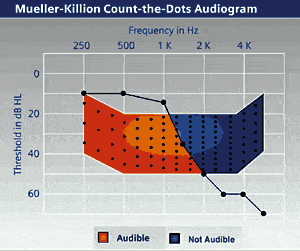Sonion has established the reputation of being a leader in the manufacturing of minuscule hearing-aid components.
Size matters. And the smaller the better, at least where hearing-aid components are concerned.
Which is why one giant of the components industry—Denmark-based Sonion—works so hard at achieving tininess.
“Our position is the smaller the component, the more design flexibility it gives to the manufacturer of the hearing instrument,” says Morten Wagner, product manager of Sonion’s Electro-Mechanical Components operation. “We’ve made a lot of progress in this regard. Some of our components are miraculously small.”
That is the trend. Smaller and smaller.
However, as components shrink in size, the challenge becomes not how to make them smaller still but how to keep them performing as well as (or, preferably, better than) their larger predecessors.
“The laws of physics are an obstacle that we’re constantly wrestling with in this regard,” Wagner says.
Newest Offerings
Much of that going-to-the-mat action takes place in the Netherlands, where Sonion operates a futuristic research-and-development laboratory. From that location, a team of experts conjures the high-quality subminiature transducers and electromechanical components for which the company is renowned.
Sonion is particularly proud of the way its laboratory has been able to unlock the secrets of transducer science leading to a dramatic reduction in microphone size (down from 50 mm3 to 12 mm3 at last count) while concomitantly increasing sensitivity and filtering out noise.
Newest of the microphones to emerge from the Sonion is a silicon transducer that embodies, according to Kenneth Teese, transducers product manager at Sonion’s US sales and service center in Minnetonka, Minn, “outstanding stability and reliability at the noise level required for hearing-instrument applications.”
This microphone has not yet been released, so it doesn’t have a name. But it will by the time it hits the market, sometime in early 2005.
Teese explains that the new microphone operates similarly to a diaphragm-equipped type, but with an important difference.
“Technically, this isn’t digital sound,” he says. “It’s still analog because sound waves are first picked up by a diaphragm. At that point, however, the sound waves are translated into a digital domain. This allows for an even smaller component size than ever before.”
The silicon microphone promises robust resistance to moisture, temperature changes, and other environmental variables. Also, consistency and yield are said to be quite strong.
“This is particularly true in directional applications where you have a pair of microphones and you need them closely matched in order to achieve optimal performance,” says Teese, who expects the microphone’s size and performance characteristics will give hearing-aid designers an unprecedented degree of freedom to innovate. “I predict it will promote a lot of thinking outside the box with regard to how transducers are utilized. It will redefine our traditional ideas about utilization and that in turn will result in different and better hearing-aid packages.”

Sonion also is readying to roll out with a second new microphone, this one cylindrical and based on the company’s 8000 series architecture.
“It has excellent capability to reject electromagnetic interference, such as from cell phones,” says Teese. “It also continues with our tradition of providing through our advanced integrated circuitry the highest possible level of protection again electrostatic discharge. Equally important, it has a very flat frequency response, which allows increased bandwidth—anywhere from 100 Hz to 10,000 Hz—and that should make it ideal for matching in directional applications.”

Due out soon, too, is a BTE receiver that will become part of the Sonion 3100 series.
“The 3100 receiver comes in a completely new size for the industry, about half the size of the traditional BTE receiver but with similar performance,” says Teese. “In addition to BTE application, the small size of the receiver will also make it suitable for custom ITE use.”
Historically, Sonion has made its electromechanical components and transducers as separate wares. Now, the company is poised to break with precedent by unveiling a product in which the two are combined.
“For quite some time, we’ve wanted to develop a combination unit, but were always thwarted by the limits of technology,” says Wagner. “That’s no longer the case. Recent technological advances have made possible this sort of combining into a fully satisfactory product.”
The new combination unit, expected to be powered by an 10A-size battery, mates a microphone to novel electromechanical components. In so doing, it will create for modular CIC instruments a minuscule platform distinguished by the presence of an integrated push button—believed to be a first for the industry, says Wagner.
“The integrated push button will enable hearing-instrument manufacturers to produce remarkably efficient, reliable instruments with easily operated user controls,” he speculates.
Dial “S” for Success
Given the way Sonion strives to advance the technology undergirding its products, some observers wonder whether the company is setting the pace for hearing-aid manufacturers or if it instead is merely opening doors that allow them to move in directions of their own choosing. Michael Ruge, president of Sonion’s Hearing Instrument Division, allows that perhaps the answer is a little of both. But in any event, it is the end user who is bound to be the biggest winner of all, he contends.
“We’re only too happy to provide our customers with guidance or application support to the extent desired,” he says. “We do, however, believe it is they, our customers, who have the primary knowledge of how to produce hearing aids, and that is something we will always respect. Our mission is to be their preferred development partner and supplier. We take that stance because we recognize that our success as a company depends on one thing—our ability to generate technical solutions that help our customers create even better products for their own customers.”
Ruge identifies the Sonion strategy overall as being one of commitment to manufacturing components cost-effectively and in high, consistent quality. This is accomplished, he reveals, by “intelligently combining manual, semiautomatic, and fully automated processes” at the company’s production facilities in Poland.
To enable Sonion to properly fulfill its mission, the company is organized along market lines rather than product lines.
“This allows us to really focus hard on developing solutions that meet needs,” says Ruge.
The concept evidently works well: Sonion today controls more than half the market worldwide for electromechanical components.
“In transducers, our market share is the second largest, which is approximately one third of that segment,” Ruge adds.
Sonion’s corporate roots trace back to 1892 when Emil Moeller founded a telephone manufacturing company that he named Emil Moeller’s Telefonfabrik. In 1937, the name changed to reflect new ownership—it became Kristian Kirk’s Telefonfabrikker.
The years went by and the company became eminently successful. So much so that it caught the attention of American phone-making icon ITT, which acquired the enterprise in 1971. At that point the name became Standard Electric Kirk. It changed again to Alcaltel Kirk A/S in 1986 after another ownership change.
From there, in 1991, the company launched a subsidiary called Kirk Acoustics A/S to mass-produce the world’s first miniaturized receiver for mobile phones. Kirk Acoustics was snapped up by Sound Holding A/S in 2000. Two years later, it was renamed SonionKirk A/S. In 2003, the Kirk part was dropped and the company became simply Sonion.
Sonion, back when it was still Kirk Acoustics, acquired a Dutch manufacturer of transducers, thereby positioning the company to start selling to the hearing-aid industry in a big way. The year was 1995.
In 1999, Sonion—as Kirk Acoustics—reported global net revenue of 498 million Danish kroners (US $81.6 million at the current exchange rate), with 33 million kroners ($5.4 million) spent on research-and-development activities. It was an upward sweep from there. In 2003 (the last year for which figures are publicly available), Sonion pulled in 743 million kroners ($121.8 million) net revenue, with 56 million kroners ($9.2 million) devoted to R&D.
At the end of 1999, the company worldwide had 1,118 employees; at the close of 2003, that number had risen to 2,331.
Showing the Way
Sonion set up shop in the United States in 1996 with the acquisition of hearing-aid component maker Microtronic.
Microtronic was started in 1974 by two entrepreneurs who based their company on a patented and highly competitive method of manufacturing hearing-instrument electromechanical components—volume controls in particular. It was a perfect fit for Sonion’s ambitions in that arena.
“Since the mid 1990s, we have successfully widened our product portfolio of components for hearing instruments and at the same time created an international platform from which to conduct business,” say Ruge. “We believe that, 5 years from now, we’ll continue to occupy a strong position in the hearing-instrument industry.”
To make sure that happens, Sonion will first have to deal with the challenge of smaller and smaller components, Ruge confides. Accordingly, Sonion’s researchers are busily studying the behavior of new materials and alloys coming from other industries, such as aerospace.
“The reality of our industry is that the cost of R & D of new materials is prohibitive, so we must, to a certain extent, rely on innovation from outside our field,” says Ruge.
Eventually, of course, the quest for ever-smaller component size will reach a level of hyper-miniaturization that customers find impractical. Make components too tiny, and the handling for assembly becomes problematic—not to mention more expensive.
“That day is far off,” Ruge assures. “For now, our focus has to be on showing the way with quality innovations in both the electromechanical and subminiature transducer categories.”
So, for Sonion, size matters. In this case, largeness—something Sonion as an enterprise clearly has working in its favor.
Rich Smith is a contributing writer for Hearing Products Report.





